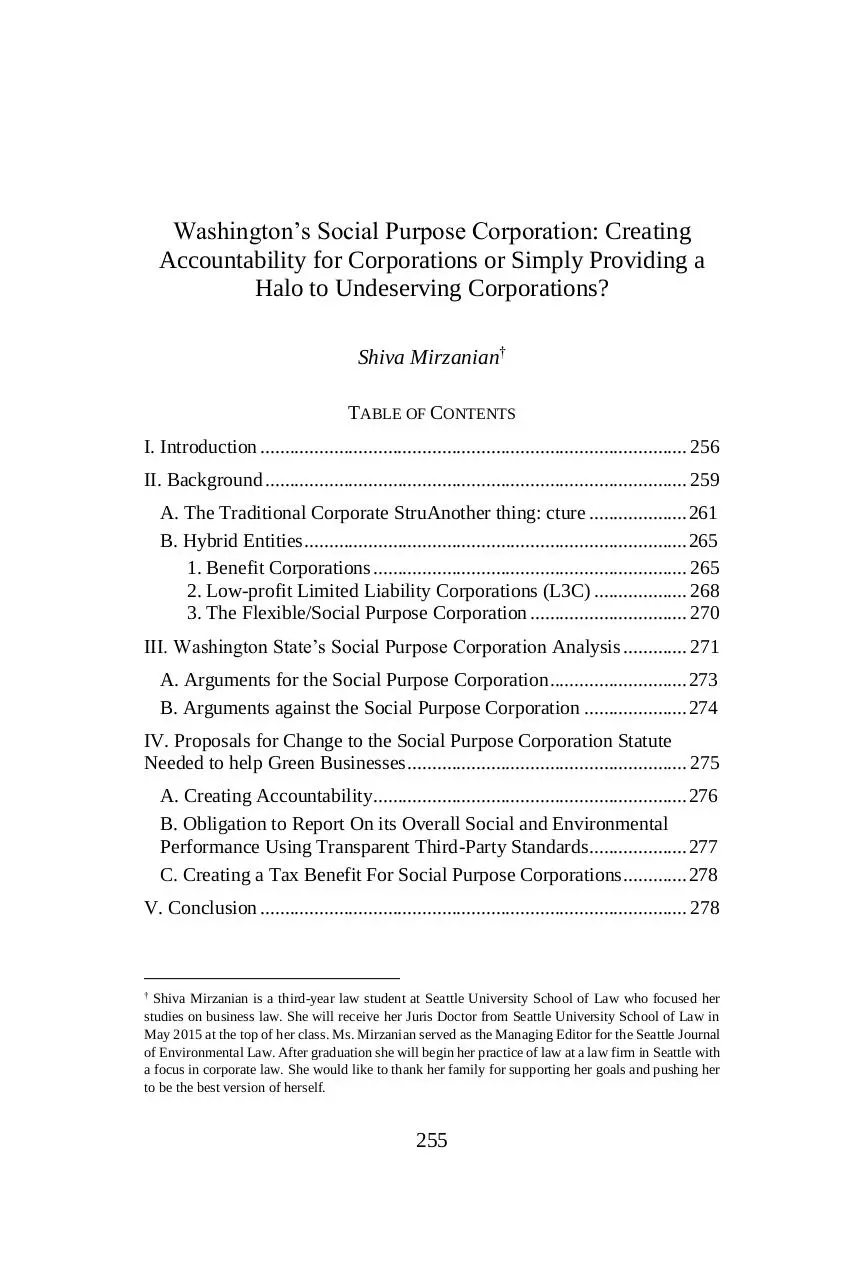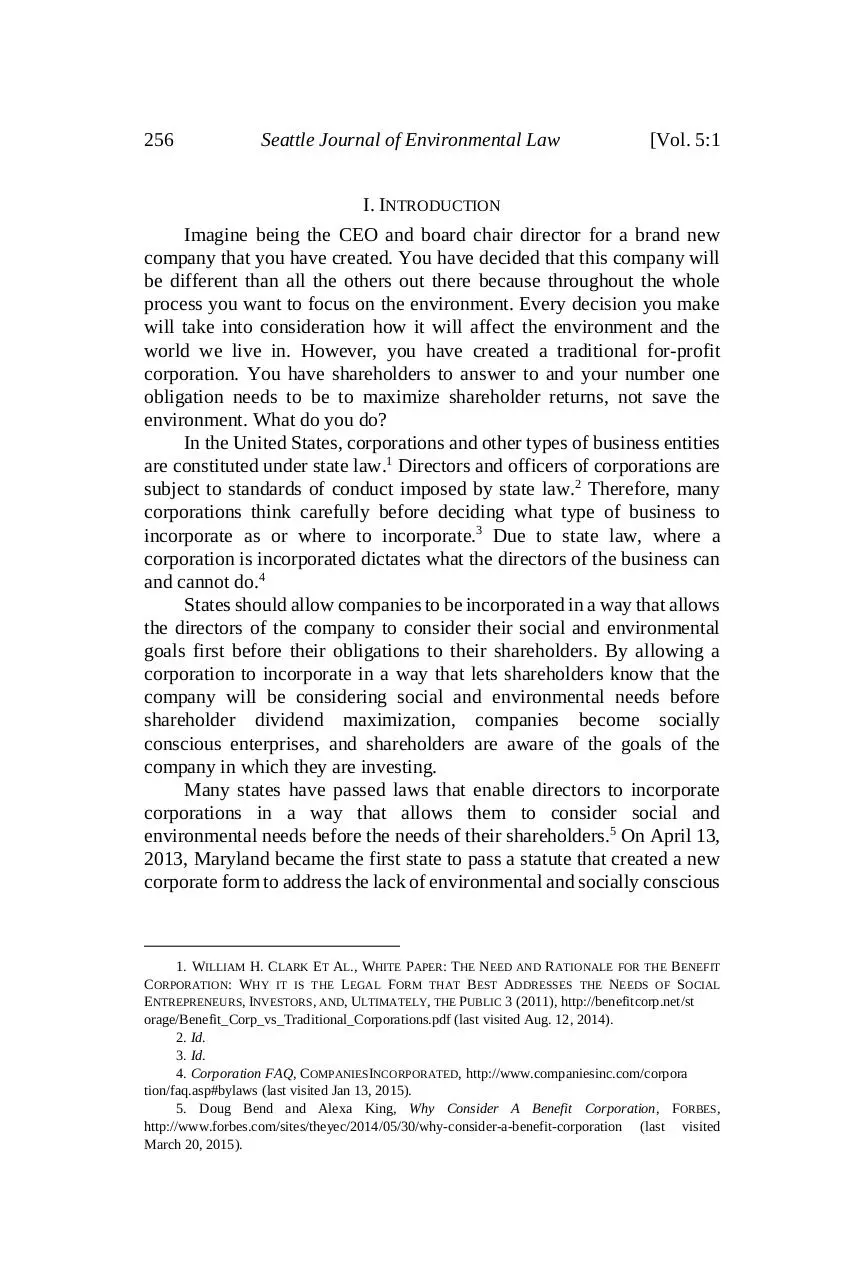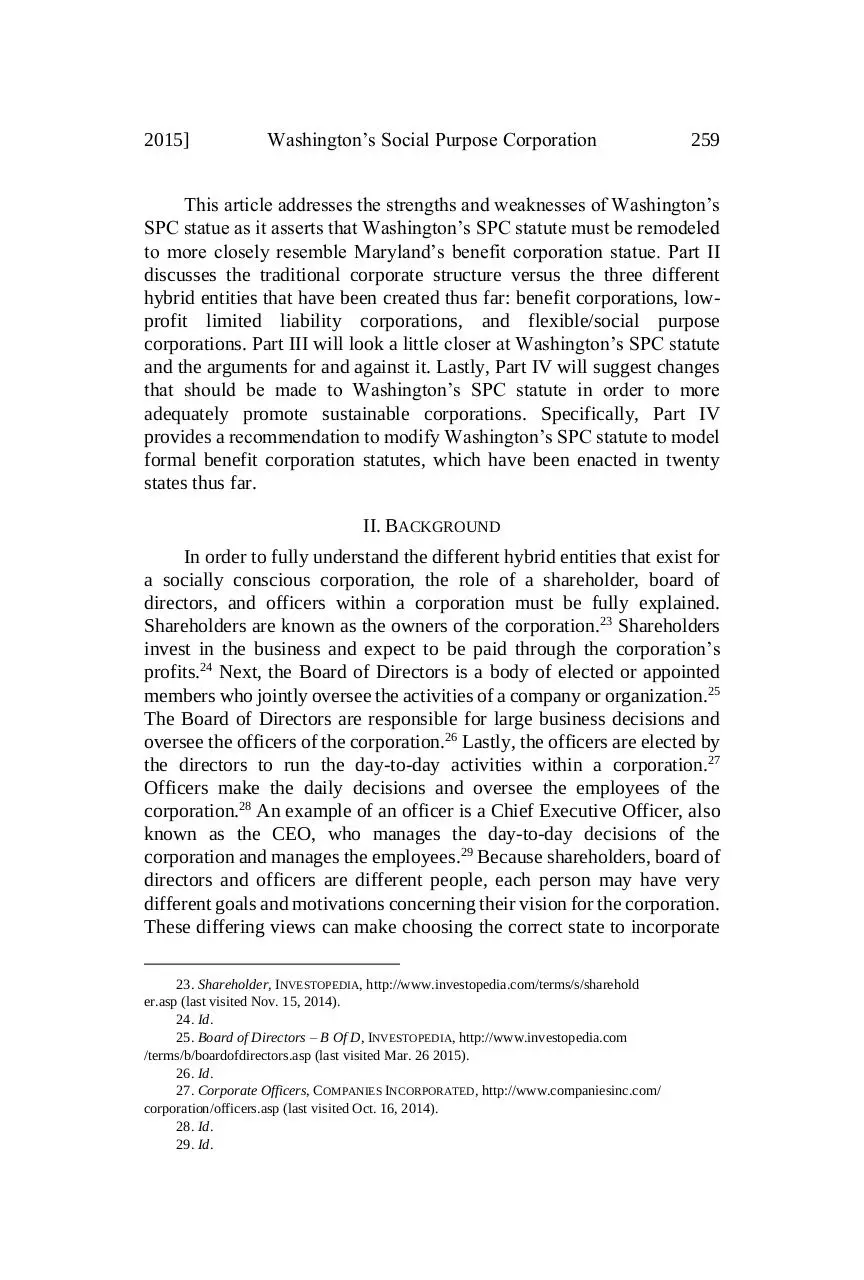10 Shiva final (PDF)
File information
Author: Tom Spahn
This PDF 1.5 document has been generated by Microsoft® Word 2013, and has been sent on pdf-archive.com on 22/07/2015 at 04:09, from IP address 66.194.x.x.
The current document download page has been viewed 627 times.
File size: 408.85 KB (26 pages).
Privacy: public file





File preview
Washington’s Social Purpose Corporation: Creating
Accountability for Corporations or Simply Providing a
Halo to Undeserving Corporations?
Shiva Mirzanian†
TABLE OF CONTENTS
I. Introduction ....................................................................................... 256
II. Background ...................................................................................... 259
A. The Traditional Corporate StruAnother thing: cture .................... 261
B. Hybrid Entities .............................................................................. 265
1. Benefit Corporations ................................................................ 265
2. Low-profit Limited Liability Corporations (L3C) ................... 268
3. The Flexible/Social Purpose Corporation ................................ 270
III. Washington State’s Social Purpose Corporation Analysis ............. 271
A. Arguments for the Social Purpose Corporation ............................ 273
B. Arguments against the Social Purpose Corporation ..................... 274
IV. Proposals for Change to the Social Purpose Corporation Statute
Needed to help Green Businesses ......................................................... 275
A. Creating Accountability................................................................ 276
B. Obligation to Report On its Overall Social and Environmental
Performance Using Transparent Third-Party Standards .................... 277
C. Creating a Tax Benefit For Social Purpose Corporations ............. 278
V. Conclusion ....................................................................................... 278
†
Shiva Mirzanian is a third-year law student at Seattle University School of Law who focused her
studies on business law. She will receive her Juris Doctor from Seattle University School of Law in
May 2015 at the top of her class. Ms. Mirzanian served as the Managing Editor for the Seattle Journal
of Environmental Law. After graduation she will begin her practice of law at a law firm in Seattle with
a focus in corporate law. She would like to thank her family for supporting her goals and pushing her
to be the best version of herself.
255
256
Seattle Journal of Environmental Law
[Vol. 5:1
I. INTRODUCTION
Imagine being the CEO and board chair director for a brand new
company that you have created. You have decided that this company will
be different than all the others out there because throughout the whole
process you want to focus on the environment. Every decision you make
will take into consideration how it will affect the environment and the
world we live in. However, you have created a traditional for-profit
corporation. You have shareholders to answer to and your number one
obligation needs to be to maximize shareholder returns, not save the
environment. What do you do?
In the United States, corporations and other types of business entities
are constituted under state law.1 Directors and officers of corporations are
subject to standards of conduct imposed by state law.2 Therefore, many
corporations think carefully before deciding what type of business to
incorporate as or where to incorporate.3 Due to state law, where a
corporation is incorporated dictates what the directors of the business can
and cannot do.4
States should allow companies to be incorporated in a way that allows
the directors of the company to consider their social and environmental
goals first before their obligations to their shareholders. By allowing a
corporation to incorporate in a way that lets shareholders know that the
company will be considering social and environmental needs before
shareholder dividend maximization, companies become socially
conscious enterprises, and shareholders are aware of the goals of the
company in which they are investing.
Many states have passed laws that enable directors to incorporate
corporations in a way that allows them to consider social and
environmental needs before the needs of their shareholders.5 On April 13,
2013, Maryland became the first state to pass a statute that created a new
corporate form to address the lack of environmental and socially conscious
1. WILLIAM H. CLARK ET AL., WHITE PAPER: THE NEED AND RATIONALE FOR THE BENEFIT
CORPORATION: WHY IT IS THE LEGAL FORM THAT BEST ADDRESSES THE NEEDS OF SOCIAL
ENTREPRENEURS, INVESTORS, AND, ULTIMATELY, THE PUBLIC 3 (2011), http://benefitcorp.net/st
orage/Benefit_Corp_vs_Traditional_Corporations.pdf (last visited Aug. 12, 2014).
2. Id.
3. Id.
4. Corporation FAQ, COMPANIESINCORPORATED, http://www.companiesinc.com/corpora
tion/faq.asp#bylaws (last visited Jan 13, 2015).
5. Doug Bend and Alexa King, Why Consider A Benefit Corporation, FORBES,
http://www.forbes.com/sites/theyec/2014/05/30/why-consider-a-benefit-corporation (last visited
March 20, 2015).
2015]
Washington’s Social Purpose Corporation
257
corporate structure.6 This new entity is called a benefit corporation, which
is a corporation that lets social entrepreneurs codify their missions in their
corporate charters, thereby allowing social entrepreneurs to consider other
factors besides maximum return on profits for their shareholders.7 The
Maryland statute enabled entrepreneurs to commit their for-profit ventures
to a specific public good, and required them to report on their contributions
to that goal.8 Benefit corporations allow businesses to make their social
mission their number one focus.
Official benefit corporate status allows entrepreneurs to foremost
prioritize employees, communities, or the environment, not just
shareholders.9 Unlike traditional corporation structures, a benefit
corporation prevents directors from facing lawsuits if they consider
nonfinancial interests, even if the considerations damage the financial
interest of the shareholders, such as the environment.10
As other states began to enact statutes modeled after Maryland’s
benefit corporation structure, Washington took to a slightly different path
by enacting Washington’s Social Purpose Corporation (SPC) bill.11 The
SPC allows a company to pursue social and environmental goals alongside
their efforts to provide financial returns.12 Washington’s SPC bill imposes
a less stringent set of verification and reporting requirements on SPCs than
what is required from a typical benefit corporation.13 Also, while benefit
corporation entrepreneurs “must” consider their social purpose in
decision-making, Washington’s SPC entrepreneurs “may” consider their
social purpose in decision-making.14 Consequently, although directors of
benefit corporations can be sued by shareholders for failing to pursue the
corporation’s social purpose, SPCs cannot be sued because SPC directors
are allowed to consider their social purpose along with other factors, such
as the shareholders, in decision-making.15
6. John Tozzi, Maryland Passes ‘Benefit Corp.’ Law for Social Entrepreneurs, BLOOMBERG
BUSINESSWEEK (Apr. 13, 2010), http://www.businessweek.com/smallbiz/running_small_business/a
rchives/2010/04/benefit_corp_bi.html (last visited Nov. 12, 2014).
7. What are B Corps?, BCORPORATION.NET (2015), https://www.bcorporation.net/what-are-bcorps (last visited Dec. 12, 2014).
8. Id.
9. Tozzi, supra note 6.
10. Id.
11. John Reed and Ame Wellman Lewis, The Social Purpose Corporation, STARTUP LAW BLOG,
http://www.startuplawblog.com/2012/05/08/social-purpose-corporation (last visited 10/28/14).
12. Tozzi, supra note 6.
13. Id.
14. Id.
15. Id.
258
Seattle Journal of Environmental Law
[Vol. 5:1
To add even more confusion to the mix, Vermont created a third
hybrid corporate entity, known as the Low-Profit Limited Liability
Company (L3C).16 L3Cs give socially conscious corporate directors a
third option when deciding how to incorporate their corporation.17 L3Cs
are considered a cross between a nonprofit organization and a for-profit
corporation, and are given tax benefits similar to a nonprofit organization.
This distinguishes an L3C from a benefit corporation and an SPC. 18
As corporations become more socially aware of their responsibilities
to the environment, it is important for states, constituents, and businesses
to understand the different hybrid entities.19 Only by understanding each
hybrid entity can a corporation determine which type of entity best suits
its goals and fully inform its constituents of what type of entity they are
investing in.20 Currently, there is much confusion over the differences
between the different hybrid entities.21 Therefore, it is important for states
to be cognizant of what each respective hybrid corporate structure offers
so that constituents and business can determine which structure best suits
their goals. Although many Washington residents in the business world
feel like the Washington’s SPC is a step in the right direction for green
businesses,22 there are additional measures that must be taken to force
these businesses to beneficially impact society and the environment when
making management decisions. Washington’s SPC Statute needs to be
transformed to resemble a benefit corporation statute in order to hold
businesses accountable for the decisions they make and ensure that they
enact a real difference. Changing the SPC statue in three ways can
accomplish this. First, change the statue so that SPCs must consider the
social purpose in decision-making, instead of simply allowing them to
consider the social purpose. Second, create an obligation for SPCs to
report on its overall social and environmental performance using
transparent third-party standards. Finally, provide a tax break to SPCs that
have successfully pursued their social purpose.
16. Gene Takagi, L3C – Low-profit Limited Liability Company, NONPROFIT LAW BLOG,
http://www.nonprofitlawblog.com/l3c (last visited Nov. 13, 2014).
17. Low-Profit LLC, VERMONT SECRETARY OF STATE, http://www.sec.state.vt.us
/corps/dobiz/llc/llc_l3c.htm (last visited April 4, 2011).
18. Takagi, supra note 16.
19. VERMONT SECRETARY OF STATE, supra note 17.
20. Takagi, supra note 16.
21. Renatto Garcia, Re-Engineering Georgia’s Corporate DNA: A Benefit Analysis and
Practicality Assessment for Benefit Corporation Legislation in Georgia, 6 J. MARSHALL L.J. 627, 631
(2013).
22. Joe Wallin, What’s positive about Washington’s new Social Purpose Corporations,
GEEKWIRE, http://www.geekwire.com/2012/big-positives-washingtons-social-purpose-corporations
(last visited Dec. 15, 2014).
2015]
Washington’s Social Purpose Corporation
259
This article addresses the strengths and weaknesses of Washington’s
SPC statue as it asserts that Washington’s SPC statute must be remodeled
to more closely resemble Maryland’s benefit corporation statue. Part II
discusses the traditional corporate structure versus the three different
hybrid entities that have been created thus far: benefit corporations, lowprofit limited liability corporations, and flexible/social purpose
corporations. Part III will look a little closer at Washington’s SPC statute
and the arguments for and against it. Lastly, Part IV will suggest changes
that should be made to Washington’s SPC statute in order to more
adequately promote sustainable corporations. Specifically, Part IV
provides a recommendation to modify Washington’s SPC statute to model
formal benefit corporation statutes, which have been enacted in twenty
states thus far.
II. BACKGROUND
In order to fully understand the different hybrid entities that exist for
a socially conscious corporation, the role of a shareholder, board of
directors, and officers within a corporation must be fully explained.
Shareholders are known as the owners of the corporation.23 Shareholders
invest in the business and expect to be paid through the corporation’s
profits.24 Next, the Board of Directors is a body of elected or appointed
members who jointly oversee the activities of a company or organization.25
The Board of Directors are responsible for large business decisions and
oversee the officers of the corporation.26 Lastly, the officers are elected by
the directors to run the day-to-day activities within a corporation.27
Officers make the daily decisions and oversee the employees of the
corporation.28 An example of an officer is a Chief Executive Officer, also
known as the CEO, who manages the day-to-day decisions of the
corporation and manages the employees.29 Because shareholders, board of
directors and officers are different people, each person may have very
different goals and motivations concerning their vision for the corporation.
These differing views can make choosing the correct state to incorporate
23. Shareholder, INVESTOPEDIA, http://www.investopedia.com/terms/s/sharehold
er.asp (last visited Nov. 15, 2014).
24. Id.
25. Board of Directors – B Of D, INVESTOPEDIA, http://www.investopedia.com
/terms/b/boardofdirectors.asp (last visited Mar. 26 2015).
26. Id.
27. Corporate Officers, COMPANIES INCORPORATED, http://www.companiesinc.com/
corporation/officers.asp (last visited Oct. 16, 2014).
28. Id.
29. Id.
260
Seattle Journal of Environmental Law
[Vol. 5:1
in and creating the best hybrid entity for the corporation difficult due to
the sheer number of competing viewpoints.
Traditionally, corporations have had the choice between two types of
business entities, nonprofit or for-profit organizations.30 A nonprofit
organization uses surplus revenues to achieve its social goals, rather than
distributing excess revenue as profit or dividends to the shareholders or
owners.31 While nonprofit organizations are permitted to generate surplus
revenues, the revenues must be retained by the organization for its selfpreservation, expansion, or long-term plans, and are not distributed to
shareholders of the nonprofit.32 The point of a nonprofit organization is
not to generate revenues, but instead to succeed at reaching the
organization’s overall social goal.33 However, an organization’s
designation as a nonprofit does not mean that it does not intend to make a
profit. Rather, the term “nonprofit” means that the organization does not
have investors, and that the organization funds will not be used to benefit
its owners.”34
Conducting socially conscious activities, such as improving the
environment, within a nonprofit legal entity presents many challenges.
The nonprofit’s organization for a narrowly defined “charitable purpose”
is one of the largest challenges.35 Due to the narrow definition of
“charitable purpose,” as defined by state and local governments, potential
nonprofits are unable to work toward their environmental and social
objective because it falls outside of the definition of “charitable
purpose.”36 Because of this, broader environmental and social
considerations cannot be effectively advanced through nonprofit
organizations.37
On the other hand, state laws require the directors of for-profit
organizations, who are elected by the shareholders, to manage or direct the
management of the corporation’s business affairs.38 The directors may
(and typically do) delegate some of their authority to the corporation’s
officers, insofar as the day-to-day activities of the corporation are
30. Antony Page, New Corporate Forms and Green Business, 37 WM. & MARY ENVTL. L. &
POL’Y REV. 347, 350 (2013).
31. Business Types, SBA, http://www.sba.gov/content/nonprofit-organizations (last visited Jan.
5, 2015).
32. Henry B. Hansmann, The Role of Nonprofit Enterprise, 89 YALE L. J. 835, 838 (1980).
33. J. Steven Ott, Understanding Nonprofit Organizations: Governance, Leadership, and
Management, BOULDER, COLORADO: WEST VIEW PRESS (2001).
34. Hansmann, supra note 32, at 838.
35. CLARK ET AL., supra note 1.
36. Id.
37. Id.
38. Id.
2015]
Washington’s Social Purpose Corporation
261
concerned.39 In discharging their statutory obligations, directors owe
certain duties—referred to as fiduciary duties—to the corporation itself
and the corporation’s shareholders.40 One of these fiduciary duties is to
maximize profits and earnings for the corporation’s shareholders.41 Every
decision made by the directors must be for the sole purpose of maximizing
profits, or they could be held liable for breaching their fiduciary duty.42 In
eBay Domestic Holdings, Inc. v. Newmark, which is discussed further
below, Chancellor Chandler held that a public-service mission, which
“seeks not to maximize the economic value of a for-profit Delaware
corporation for the benefit of its stockholders” is an invalid corporate
purpose and inconsistent with directors’ fiduciary duties.43 In essence, the
Chancellor firmly stated that that the only purpose of a for-profit
corporation should be to maximize shareholder investment and not to
pursue any social purpose.
A. The Traditional Corporate Structure
A for-profit corporation is a business whose primary goal is making
money (a profit), as opposed to focusing on a goal, such as helping the
environment.44 Thus, for-profit corporations are legally obligated to solely
maximize shareholder profits. Most companies that the average consumer
sees on a day-to-day basis are for-profit corporations.45
The purpose of a for-profit corporation’s obligation to solely
maximize shareholder profit stems back to 1919 in one of the most famous
cases in business law, Dodge v. Ford Motor Co.46 The plaintiff, Dodge, a
shareholder of the corporation Ford Motor Co., brought an action against
Ford in an attempt to force Ford to pay a more substantial dividend because
Ford was sitting on a large amount of cash and had made questionable
decisions regarding the business’s excess profits.47 The Michigan Supreme
Court held that Ford Motor Company’s nonpayment of special dividends
39. Id.
40. Douglas Y. Park, Fiduciary Duties of the board of Directors: The Basics, DYP ADVISORS
(August 22nd, 2011), http://www.dypadvisors.com/2011/08/22/fiduciary-duties-of-board-ofdirectors-basics/.
41. CLARK ET AL., supra note 1.
42. Social Purpose Corporations: Just the FAQs, HELSELL FETTERMAN, http://www.helsell.
com/wp-content/uploads/FAQ_Social_Purpose.pdf (last visited Spring 2015).
43. eBay Domestic Holdings, Inc. v. Newmark, 16 A.3d 1 (2010).
44. For-Profit Organization, BUSINESSDICTIONARY.COM, http://www.businessdicti
onary.com/definition/for-profit-organization.html (last visited Jan 16, 2015).
45. Id.
46. CLARK ET AL., supra note 1.
47. Dodge v. Ford Motor Co., 170 N.W. 668 (Mich. 1919).
262
Seattle Journal of Environmental Law
[Vol. 5:1
while it was sitting on so much cash was impermissible.48 Although Ford’s
motive for withholding cash from its shareholders was to put the money
into further expanding the corporation, the Court held that the
corporation’s sole purpose was to make money for its shareholders.49
Thus, the corporation could not arbitrarily withhold money that could and
should go to their shareholders, even if the reasoning for withholding the
money was to further the company’s goals.50 However, the Court did say
that it would not interfere with the Corporation’s business decisions.51
A recent example that reaffirmed the primacy of wealth
maximization for shareholders was the case of eBay v. Newmark,
regarding eBay as a minority shareholder of Craigslist.52 Although
Craigslist is a for-profit corporation, it operates its business largely as a
community service, allowing users to post classified advertisements free
of charge.53 In contrast, eBay operates its business with the goal of
maximizing revenues, profits, and market share.54 Despite these
differences, eBay made an investment in Craigslist and became a minority
shareholder.55 A dispute arose when it became apparent that eBay had
invested in Craigslist with an eye toward forming an international
partnership and making the company a subsidiary of eBay.56 Upon
learning this, Craigslist took defensive measures to make sure that control
would not get into eBay’s hands if something were to happen to
Craigslist’s founders.57 The Court ruled, however, “having chosen a forprofit corporate form, the Craigslist directors are bound by the fiduciary
duties and standards that accompany that form, including acting to
promote the value of the corporation for the benefit of its stockholders.”58
A final example reaffirming the primacy of wealth maximization for
shareholders occurred in 2000.59 The socially conscious ice cream maker
Ben & Jerry’s faced a problem when it wanted to sell the company. 60 The
48. Id.
49. Id.
50. Id.
51. Id.
52. eBay Domestic Holdings, Inc. v. Newmark, 16 A.3d 1 (2010).
53. Id. at 8.
54. Id. at 9.
55. Id. at 34.
56. Id. at 15.
57. Id. at 35.
58. Id. at 34.
59. Anthony Page & Robert A. Katz, The Truth About Ben and Jerry’s, STANFORD SOCIAL
INNOVATION REVIEW (Fall 2012), http://www.ssireview.org/articles/entry/the_trut
h_about_ben_and_jerrys (last visited Apr. 2, 2015).
60. Id.
2015]
Washington’s Social Purpose Corporation
263
directors of the company wanted to sell Ben & Jerry’s to a group of
investors led by founders Ben Cohen and Jerry Greenfield, but the French
food giant Unilever was offering a better share price.61 The difference in
corporate governance between the two companies was not to be
considered because the company was a for-profit company, and the only
goal of the directors was to get the best price for its shareholders.62 It did
not matter that one had a more socially responsible management style.63
The laws of corporate governance forced the board of directors to sell the
company to the better-funded French, lest they be sued for failing to put
shareholders’ financial interests first.64 This is exactly the kind of dilemma
that the benefit corporation is seeking to eliminate.
The legal issue of fiduciary responsibility has long been seen as a
barrier to companies wanting to take more proactive social and
environmental measures.65 However, for many companies, it has been seen
as a fig leaf to avoid taking substantive measures to clean up pollution or
end sourcing from sweatshops.66
In a for-profit corporation, “there is one and only one social
responsibility of businesses; to use its resources and engage in activities
designed to increase its profits, so long as it stays within the rules of the
games, which is to say, engages in open and free competition without
deception or fraud.”67 A corporate executive, also known as a board
director, is an employee of the owners of the business (shareholders).68 His
responsibility is to conduct the business in accordance with the
shareholders desires, which generally will be to make as much money as
possible.69 The argument follows that if a corporation’s only purpose is to
maximize shareholder profits, then it is unable to pursue its social or
61. Manish Bisaria et. Al, Unilever’s Acquisition of Ben & Jerry’s: Background, Motive, and
Impact, U.N.C. KENAN-FLAGLER BUSINESS SCHOOL (2005), https://extranet.kenanflagler.unc.edu/kicse/ORIG%20Shared%20Documents/Unilever%27s%20Acquisition%20of%20Be
n%20and%20Jerry%27s.pdf.
62. Id.
63. Id.
64. Page & Katz, supra note 59.
65. Joel Makower, California’s Bold Move to Legitimize Sustainable Business, GREENBIZ.COM
(Feb. 14, 2011), http://www.greenbiz.com/blog/2011/02/14/california%E2%80%99s-move-legalizesustainable-business.
66. Id.
67. See Milton Friedman, The Social Responsibility of Business Is to Increase Its Profits, N.Y.
TIMES, Sept. 13, 1970, available at http://www.colorado.edu/studentgroups/libertarians/issue
s/friedman-soc-resp-business.html.
68. Roger Donway, Do Shareholders “Own” a Corporation?, THE ATLAS SOCIETY’S BUSINESS
RIGHTS CENTER, http://www.atlassociety.org/brc/shareholders_owners_corporation (last visited Dec.
12, 2014).
69. Id.
Download 10 Shiva final
10 Shiva final.pdf (PDF, 408.85 KB)
Download PDF
Share this file on social networks
Link to this page
Permanent link
Use the permanent link to the download page to share your document on Facebook, Twitter, LinkedIn, or directly with a contact by e-Mail, Messenger, Whatsapp, Line..
Short link
Use the short link to share your document on Twitter or by text message (SMS)
HTML Code
Copy the following HTML code to share your document on a Website or Blog
QR Code to this page

This file has been shared publicly by a user of PDF Archive.
Document ID: 0000289224.